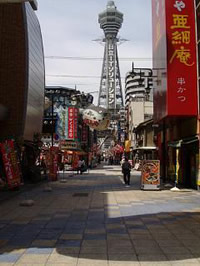|
In fiscal 2002, between July and the following February,
I visited several sites where performing arts and other
cultural activities are underway in Osaka. After surveying
the situation at each location, I wrote a series of
reports. This year I am continuing to report my findings.
In publishing these articles, I touched upon the following
fundamental issues in each situation.
This fiscal year I hope to delve deeper into my examination
of "culture." What exactly is culture? How
is it different from entertainment? What conditions
are necessary for culture? I would like to consider
these questions as best I can using concrete examples.
 The
main theme of this installment are the cultural activities
("The Shin-Sekai Art Park Project") currently
being organized at the FestivalGate amusement complex
in Osaka's Naniwa Ward. FestivalGate, which was originally
designed as an entertainment facility, had begun to
lose its attractiveness, and as a result, could no longer
draw as many customers, to the point that it is currently
operating under a heavy deficit. The vacant commercial
spaces have now been leased to culturally active NPOs
at no cost. The objective behind the decision was "to
increase the number of art-related NPOs and create a
regular urban art community in a commercial facility
based on the premise that average citizens would be
free to visit." The project is a pioneering example
of the City of Osaka's cultural policies. I decided
to take a closer look at the project. First, I would
like to discuss the NPO, remo: record, expression and
medium-organization, about which I will gradually provide
more details in future articles. The
main theme of this installment are the cultural activities
("The Shin-Sekai Art Park Project") currently
being organized at the FestivalGate amusement complex
in Osaka's Naniwa Ward. FestivalGate, which was originally
designed as an entertainment facility, had begun to
lose its attractiveness, and as a result, could no longer
draw as many customers, to the point that it is currently
operating under a heavy deficit. The vacant commercial
spaces have now been leased to culturally active NPOs
at no cost. The objective behind the decision was "to
increase the number of art-related NPOs and create a
regular urban art community in a commercial facility
based on the premise that average citizens would be
free to visit." The project is a pioneering example
of the City of Osaka's cultural policies. I decided
to take a closer look at the project. First, I would
like to discuss the NPO, remo: record, expression and
medium-organization, about which I will gradually provide
more details in future articles.
|